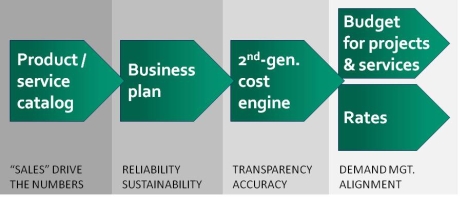| | Excerpt from WWW.FullCost.COM, © 2020 N. Dean Meyer and Associates Inc.
How does the FullCost planning process work?....

FullCost includes a step-by-step method that takes a leadership team through its integrated business and budget planning process, and the development of a catalog with rates.
FAQ: Why annual business planning and budgeting should be an integrated process....
FAQ: Why budgeting and rate setting should be an integrated process....
More on the FullCost documentation....
The FullCost implementation process is not technical; it's a process of learning to plan a business within a business.
There are many flexible options for how you implement FullCost -- from a tool used only by your planning/finance team to a transformational process that engages your leadership team.
STEPS IN THE FullCost PLANNING PROCESS
Key deliverables of each phase are underlined.
[Approximate times in months are for full transformation process.]
- Project planning, engage leadership team, entrepreneurial lines of business. [1]
What happens at this step, results, lessons learned....
- Product/service catalog (internal and external). [2]
What happens at this step, results, lessons learned....
- "Sales" forecast (specific projects, SLAs), teamwork (operating model). [3]
What happens at this step, results, lessons learned....
- Business plan (fulfillment strategy with headcount, costs). [2]
What happens at this step, results, lessons learned....
- Internal support agreements (group-to-group, overhead). [1]
What happens at this step, results, lessons learned....
- Revenues, tuning, and executive scrutiny. [2]
What happens at this step, results, lessons learned....
- Presentation and negotiation of the budget. [?]
What happens at this step, results, lessons learned....
- Publish rates, upload tracking data and metrics. [1]
What happens at this step, results, lessons learned....
Detailed project plan, workshop agendas, tasks....
With a dedicated project team, the entire model (budget and catalog with rates) can be set up in 6-8 months.
| "We don't have the time to do it quickly!" |
Dave Anderson
President, American Family Insurance |
Even in a full 10-month transformation process, the results and benefits accrue quickly:
- Lines of business within the organization will be defined within one month.
- Catalogs of products and services, with definition of pricing units and brief descriptions of deliverables, will be finished by month 3.
- A comprehensive demand forecast by client business unit, with both a keep-the-lights-on and optimistic scenarios, complete with synchronizing internal primes and subcontractors (project and service-delivery teams), will be finished by month 6.
- The fulfillment strategy, including required staffing with billable-time ratios and all costs, will be completed by month 8.
- Internal sales, including overhead, will be scrutinized and approved by month 9.
- All indirect costs will be amortized to products and services, and input errors will be resolved, by month 9.
- Executive scrutiny will be done, and reports for client presentations will be prepared, in month 10.
After the first year, annual business and budget planning (with revision of rates) takes approximately three months.
You can even begin the process with a small, practical first step: Your service catalog is the foundation of any investment-based budgeting and rate-setting process. And it's not difficult. Here's a practical process that delivers a world-class catalog in just three months.
Or if you've already built a cost model, a practical next step might be an independent assessment of the strengths and weaknesses of your cost model gives you advanced warning of problems, before you find yourself on the defensive in front of clients and auditors. It can also give you a stamp of approval on all you've done right.
|



